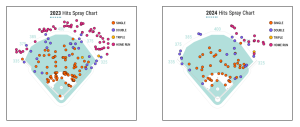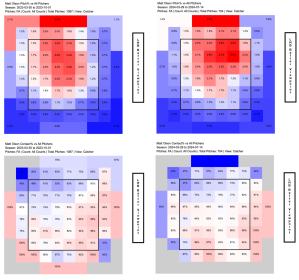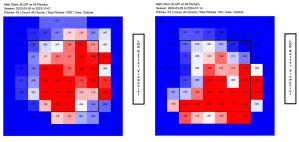Since making his Major League debut in 2017, Matt Olson has been considered one of the best first basemen in all of Major League Baseball. Throughout his first six full seasons, Olson has produced a wRC+ over 130 in three separate seasons, including last season where he produced a 160 wRC+ and finished fourth place in voting for the National League Most Valuable Player. While he has been a foundational piece of the Atlanta Braves lineup since being acquired by the organization after the departure of Freddie Freeman, Olson has struggled to start the 2024 season, producing a 99 wRC+ over 398 plate appearances during the first half of the season. This article will explore what has caused Matt Olson’s rocky start to the 2024 season, and attempt to identify changes that he can make to his offensive approach to once again reach his lofty offensive potential.
Batted Ball Profile
Since being acquired by the Atlanta Braves, Matt Olson has been one of the best offensive first basemen in all of Major League Baseball, producing a wRC+ of at least 120 in each of his first two seasons with the Braves. So far this season, Olson’s offensive production has been slightly below league average with a 99 wRC+ due to a decrease in power and a slight increase in strikeouts.
As shown by the table above, Olson’s decrease in offensive production this season can be attributed to a decrease in isolated power (.321 to .176), a slight increase in strikeout rate (23.2% to 27.4%), and a decrease in walk rate (14.4% to 9.0%). While Olson’s current wOBA of .311 is underperforming his .326 xwOBA, he is currently producing a .291 BABIP that is in line with his career average, indicating that he has likely not been experiencing negative “batted ball luck” so far this season.
Olson has also been known for generating impressive exit velocities throughout his career, with his 55.5% hard hit rate ranking as the third-highest among qualified hitters last season. Being able to hit the ball hard with consistency is advantageous to the hitter as they are not only able to generate power to all fields but are also more likely to have balls hit into play that result in base hits. This season, Olson has seen a decline in all of his batted ball quality metrics which could explain the decrease in power he has experienced so far.
As shown by the table above, Olson has experienced decreases in hard hit rate (55.5% to 46.2%), barrel rate (16.4% to 10.1%), and max. exit velocity (118.6 to 113.9) so far this season. While these metrics still grade as above league average, they are not in line with the elite levels of batted ball quality that Olson has been able to produce in the past. These declines in exit velocity have also impacted his expected statistics, with his xwOBA decreasing from .392 in 2023 to .326 so far this season.
As mentioned earlier, hitting the ball hard with consistency allows for a hitter to generate power to all fields, due to the greater amounts of exit velocity required to hit the ball for power to center and opposite field as opposed to the pull side. While Olson still has an above-average hard hit and barrel rate, an analysis of his spray chart from this season shows that he has lost his ability to hit for opposite-field power so far this season.

As shown by the spray charts above, Olson hit ~ 10 home runs to the opposite field last season while nearly all of his home runs this season have been to the pull side. It is plausible that a decline in exit velocity has turned fly balls that are hit to this part of the field into outs. Olson’s pull rate has increased from 38.2% to 45.7% this season, and it is possible that he attempted to make a concerted effort to pull more balls this season which caused him to disrupt or lose his timing as opposed to hitting for more power.
The main question is why has Olson seen a decline in hard hit rate, barrel rate, and max exit velocity so far this season? This is an example of some of the insights that Statcast’s new bat tracking data can capture once multiple seasons of data are available to the public, as bat speed is correlated with exit velocity, and decreases in bat speed year-over-year can potentially explain decreases in exit velocity year-over-year. Only data from the 2024 season is available to the public via Statcast, however, a Driveline Baseball video describing the effects of bat speed on offensive production features an average bat speed leaderboard from 2023 which includes Olson’s bat speed data from last season.
Assuming the Driveline bat speed data is collected in a similar manner to the Statcast bat speed data, Olson has seen the largest decrease in year-over-year bat speed among the top 10 leaders from last season. This helps explain the decrease in batted ball quality that Olson has experienced this season, as swinging the bat slower results in softer contact. Perhaps focusing on improving his bat speed, such as undergoing weighted bat training, could result in Olson regaining the batted ball quality he has produced over the past couple of seasons. At age 30, this decrease in bat speed is a bit concerning, as aging curves indicate that bat speed declines significantly after a hitter’s age 31 season. However, veterans such as J.D. Martinez have used weighted bats and bat speed training to improve their exit velocity and resist the aging curve in recent seasons, and I would expect that Olson would be able to accomplish this as well. While the decline in batted ball quality has been a major contributor to Olson’s rocky start to the 2024 season, training for bat speed and regaining his timing should allow him to get closer to his previous levels of offensive production in the future.
Pitch Distribution
Another reason why Matt Olson has been off to a rocky start to the 2024 season has been due to opposing pitchers attacking his weaknesses more frequently. As has been discussed in many articles this season, four-seam fastball usage has been down across Major League Baseball in 2024 due to pitchers countering the adjustments that hitters have made on high-ride fastballs located up in the strike zone. Contrary to league trends, pitchers have increased their usage of four-seam fastballs against Olson this season, from 36.6% to 41.0%.

As shown by the heat maps above, pitchers have been throwing more up-and-in fastballs to Olson so far this season. Olson has also had a significant hole on fastballs up and away throughout his career, and Olson still frequently swings and misses on four-seamers located in this location. The primary reason why I believe pitchers are starting to throw more fastballs up-and-in to Olson this season is because his slugging percentage against four-seamers in this location of zone significantly decreased during the first half of the season.

When a hitter attempts to pull more pitches for power, they typically focus on pulling pitches located on the inner third of the plate, as hitters frequently “roll over” and hit weak ground balls when pulling pitches located on the outer third. Given that Olson appears to have placed a greater emphasis on pulling the ball this season given his increased pull rate, it is a bit surprising to see that he producing a lower slugging percentage on pitches he is presumably trying to pull. This weakness has made it easier for pitchers to gameplan their approaches to him, as locating a four-seamer up in the zone will likely result in a whiff or sub-optimal contact. Utilizing a four-seamer up in the zone to a “pull hitter” opens up the pitcher (especially a right-handed hitter) to utilize a changeup down in the zone to generate swing-and-miss, and Olson has produced a career-high 32.5% whiff rate against changeups this season.
I am curious as to whether Olson’s declining bat speed has played a role in this change in approach from opposing hitters. Olson’s bat speed is still in the 81st percentile amongst Major League hitters, so it is inaccurate to suggest that Olson has anything near a “slow bat”. However, faster bat speeds perform better against faster pitches and perhaps pitchers have identified that his declining bat speed makes him more susceptible to four-seam fastballs. Improving his ability to hit up-and-in fastballs for power should be a priority for Olson, as fixing this hole will force pitchers to change their approaches against him and make it more difficult to exploit his weakness against up-and-away fastballs.
Concluding Thoughts
To once again reach his lofty offensive potential, Matt Olson needs to regain his exit velocity (potentially by training to increase his bat speed) and close up the hole on four-seam fastballs up and in that pitchers have attacked him with this season. After producing a 99 wRC+ over the first half, the question most analysts are asking is how much production can we expect from Olson over the second half of the season? Projection systems are bullish on Olson over the remainder of the season, with the BAT X and Steamer both projecting a wRC+ of at least 130 for Olson in the second half. Both projection systems believe that Olson will regain his previous power during the second half, and it is certainly possible if he can effectively cover up-and-in four-seamers again. Matt Olson is still a foundational piece of the lineup Atlanta Braves; however, he needs to make a couple of adjustments in order to reclaim and sustain his high level of offensive production throughout his 30s.
